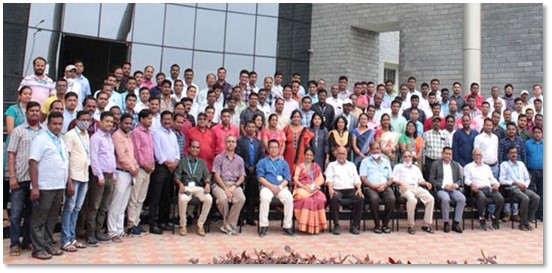
One of the outreach activities of the Kotak IISc AI-ML Centre is contributing to high-school teacher training activities at IISc Challakere. Each batch of teachers typically includes Mathematics and Science teachers. The training programme for Mathematics teachers is split roughly equally between lectures (where instructors highlight common student misconceptions and suggest ways to identify and correct them) and problem-solving. The latter includes both practice questions and quizzes, and provides some assurance that teachers are immediately benefitting from the programme.
From 5–7 September 2022, Dr Viraj Kumar (Visiting Professor at the Centre) contributed to training a batch of 32 high-school Mathematics teachers from the Karnataka Residential Educational Institutions Society (KREIS), a network of over 800 schools serving socially- and educationally-backward communities in Karnataka. Based on surveys conducted during previous training sessions, teachers reported difficulties in helping students solve word problems. Here, the problem is given in the natural language (Kannada or English, as per the medium of instruction) and students must follow the following sequence of steps:
- Interpret the question (natural language comprehension).
- Convert it into an appropriate mathematical form (as per their comprehension).
- Solve the problem in its mathematical form.
Several teachers reported that students struggle with steps 1 and 2. Therefore, Kumar experimented with a change to the training programme. In the traditional programme, the trainer discusses model solutions to the practice problems as soon as teachers have finished solving them. Instead, he presented teachers with incorrect solutions (ostensibly made by students, but in fact carefully constructed by Kumar) where the error lay in Steps 1 and 2 of the above sequence. Two examples of such problems are shown.

The intention was for teachers to use such problems as illustrations for their students, to show common errors in comprehending the natural language of the problem and translating it into mathematics. Disconcertingly, many teachers were themselves unable to recognize the errors in these incorrect solutions, even though they had correctly solved the same problem a few minutes earlier! Kumar is now investigating whether this phenomenon is observed in other batches of Mathematics teachers as well. If so, the experimental changes made to the training may need to be officially integrated into the programme, to provide teachers with practice in critiquing student solutions more rigorously than mere ‘pattern matching’, which some teachers have anecdotally reported as their only evaluation strategy.
